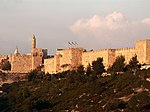Siege of Jerusalem (1187)

The siege of Jerusalem lasted from 20 September to 2 October 1187, when Balian of Ibelin surrendered the city to Saladin. Earlier that summer, Saladin had defeated the kingdom's army and conquered several cities. Balian was charged with organizing a defense. The city was full of refugees but had few soldiers. Despite this fact the defenders managed to repulse several attempts by Saladin's army to take the city by storm. Balian bargained with Saladin to buy safe passage for many, and the city was peacefully surrendered with limited bloodshed. Though Jerusalem fell, it was not the end of the Kingdom of Jerusalem, as the capital shifted first to Tyre and later to Acre after the Third Crusade. Latin Christians responded in 1189 by launching the Third Crusade led by Richard the Lionheart, Philip Augustus, and Frederick Barbarossa separately. In Jerusalem, Saladin restored Muslim holy sites and generally showed tolerance towards Christians; he allowed Orthodox and Eastern Christian pilgrims to visit the holy sites freely -- though Frankish (i.e. Catholic) pilgrims were required to pay a fee for entry. The control of Christian affairs in the city was handed over to the Ecumenical Patriarch of Constantinople.
Excerpt from the Wikipedia article Siege of Jerusalem (1187) (License: CC BY-SA 3.0, Authors, Images).Siege of Jerusalem (1187)
Agripas, Jerusalem Nahlaot
Geographical coordinates (GPS) Address Nearby Places Show on map
Geographical coordinates (GPS)
| Latitude | Longitude |
|---|---|
| N 31.7833 ° | E 35.2167 ° |
Address
Agripas 8
9422904 Jerusalem, Nahlaot
Jerusalem District, Israel
Open on Google Maps








